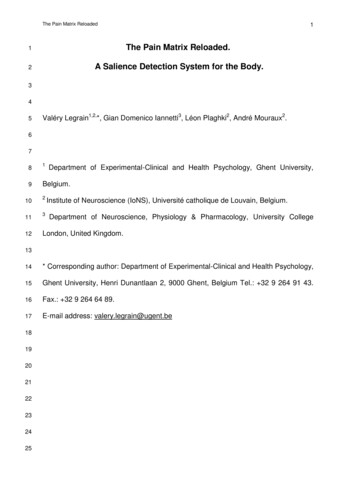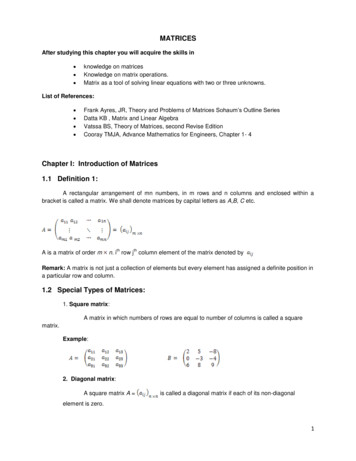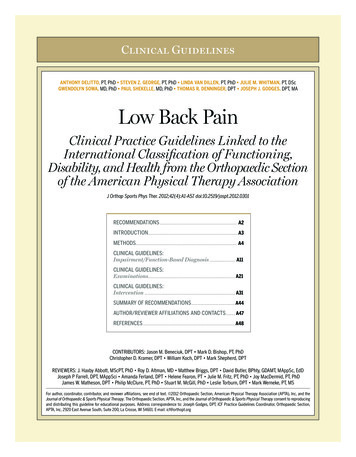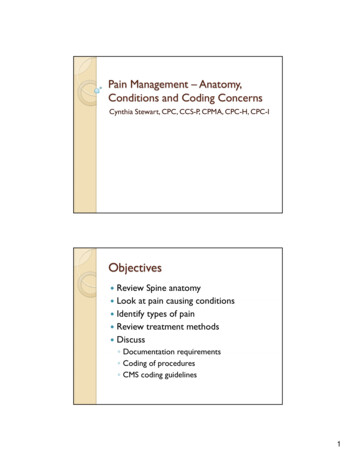
Transcription
The Pain Matrix Reloaded11The Pain Matrix Reloaded.2A Salience Detection System for the Body.345Valéry Legrain1,2,*, Gian Domenico Iannetti3, Léon Plaghki2, André Mouraux2.67891011121Department of Experimental-Clinical and Health Psychology, Ghent University,Belgium.23Institute of Neuroscience (IoNS), Université catholique de Louvain, Belgium.Department of Neuroscience, Physiology & Pharmacology, University CollegeLondon, United Kingdom.1314* Corresponding author: Department of Experimental-Clinical and Health Psychology,15Ghent University, Henri Dunantlaan 2, 9000 Ghent, Belgium Tel.: 32 9 264 91 43.16Fax.: 32 9 264 64 89.17E-mail address: valery.legrain@ugent.be1819202122232425
The Pain Matrix Reloaded21ABSTRACT (word count: 247)2Neuroimaging and neurophysiological studies have shown that nociceptive stimuli3elicit responses in an extensive cortical network including somatosensory, insular4and cingulate areas, as well as frontal and parietal areas. This network, often5referred to as the “pain matrix”, is viewed as representing the activity by which the6intensity and unpleasantness of the percept elicited by a nociceptive stimulus are7represented. However, recent experiments have reported (i) that pain intensity can8be dissociated from the magnitude of responses in the “pain matrix”, (ii) that the9responses in the “pain matrix” are strongly influenced by the context within which the10nociceptive stimuli appears, and (iii) that non-nociceptive stimuli can elicit cortical11responses with a spatial configuration similar to that of the “pain matrix”. For these12reasons, we propose an alternative view of the functional significance of this cortical13network, in which it reflects a system involved in detecting, orienting attention14towards, and reacting to the occurrence of salient sensory events. This cortical15network might represent a basic mechanism through which significant events for the16body‟s integrity are detected, regardless of the sensory channel through which these17events are conveyed. This function would involve the construction of a multimodal18cortical representation of the body and nearby space. Under the assumption that this19network acts as a defensive system signaling potentially damaging threats for the20body, emphasis is no longer on the quality of the sensation elicited by noxious stimuli21but on the action prompted by the occurrence of potential threats.2223KEYWORDS24Pain, Nociception, Salience, Attention, Multimodal, Peripersonal space25
The Pain Matrix Reloaded1TABLE OF CONTENTS21. Introduction.32. Relationship between magnitude of responses in the “pain matrix” and intensity of4pain.53. The effect of novelty and orienting of attention.64. Activation of the “pain matrix” by non-nociceptive inputs.75. A salience detection system.86. A salience detection system for the body.97. Towards a neuropsychology of threat detection.101112131415161718192021222324258. Conclusion.3
The Pain Matrix Reloaded141. INTRODUCTION2Nociception, which is initiated by the activation of peripheral nociceptors, may3be defined as the activity in the peripheral and central nervous system elicited by4mechanical, thermal or chemical stimuli having the potential to inflict tissue damage5(Sherrington, 1906). However, nociception is not synonymous with pain, which is6experienced as a conscious percept. Indeed, nociception can trigger brain responses7without necessarily causing the feeling of pain (Baumgärtner et al., 2006; Hofbauer et8al., 2004; Lee et al., 2009). On the other hand, pain can occur in the absence of9nociceptive input (Nikolajsen & Jensen, 2006).10In the last decades, a very large number of studies have aimed at better11understanding how the cortex processes nociceptive stimuli and how the experience12of pain may emerge from this processing. In humans, most of these studies have13relied on non-invasive functional neuroimaging techniques to sample, directly (e.g.,14electroencephalography [EEG], magnetoencephalography [MEG]) or indirectly (e.g.,15positron emission tomography [PET], functional magnetic resonance imaging [fMRI])16the neural activity triggered by various kinds of nociceptive stimuli. These studies17have shown that nociceptive stimuli elicit responses within a very wide array of18subcortical and cortical brain structures (see Apkarian et al., 2005; Bushnell &19Apkarian, 2006; García-Larrea et al., 2003; Ingvar, 1999; Peyron et al., 2000; Porro,202003; Rainville, 2002; Tracey & Mantyh, 2007; Treede et al., 1999). Because21responses in some of these structures appear to be observed consistently across22studies, and seem to be correlated with the perceived intensity of pain, they have23been hypothesized to be preferentially involved in experiencing pain. Hence,24structures such as the primary (SI) and secondary (SII) somatosensory, the cingulate25and the insular cortices are often referred to as belonging to the so-called “pain
The Pain Matrix Reloaded51matrix”, i.e. a network of cortical areas through which pain is generated from2nociception (Ingvar, 1999; Peyron et al., 2000; Porro, 2003; Rainville, 2002; Tracey &3Manthy, 2007)1. To support the idea that this network is specifically involved in the4perception of pain, investigators often put forward the following arguments: (i) that5the perceived intensity of pain correlates strongly with the magnitude of the neural6responses in the “pain matrix” (Bornhövd et al., 2002; Büchel et al., 2002; Coghill et7al., 1999; Derbyshire et al., 1997; Iannetti et al., 2005; Tolle et al., 1999), and (ii) that8factors modulating pain also modulate the magnitude of the neural responses in the9“pain matrix” (Hofbauer et al., 2001; Rainville et al., 1997). Therefore, the activity of10that network would constitute a “representation” (Treede et al., 1999) or a “signature”11(Tracey & Mantyh, 2007) of pain in the brain, and, thereby, would provide a “window”12to study the neural processes underlying pain function and dysfunction in humans13(Apkarian et al., 2005). In other words, according to many authors, nociceptive input14would generate a conscious percept of pain through the activity it elicits in the15network constituting the “pain matrix”, and, hence, measuring the activity within this16network would constitute a direct and objective measure of the actual experience of17pain (Borsook et al., 2010).18It is actually difficult to provide a unique and consensual definition of the “pain19matrix”. Some authors do not consider each area belonging to the “pain matrix” as20specifically and individually involved in the perception of pain. Instead, they propose1It should be emphasized that although SI, SII, the insula and the cingulate cortex are oftenconsidered to constitute the core of the so-called “pain matrix”, several studies have shown that otherbrain structures can respond to nociceptive stimuli, such as the amygdala, the prefrontal and parietalcortices, various parts of the brainstem, as well as the cerebellum. These are often not explicitlyincluded in the “pain matrix” either because they have not been consistently identified as respondingto nociceptive input across different studies (Peyron et al., 2000), or because of the a prioriassumption that they reflect brain processes that are unspecific for pain (Apkarian et al., 2005). Forexample, the amygdala is thought to be involved in assigning emotional valence to any type ofstimulus (Tracey & Mantyh, 2007), whereas prefrontal and parietal cortices are thought to be involvedin the direction of attention towards any type of stimulus (Peyron et al., 2000). Finally, the rostral partof the prefrontal cortex and the periaqueductal grey matter are thought to participate to descendingnociceptive control mechanisms, and, hence, to modulate but not contribute directly the emergence ofa painful percept (Tracey & Mantyh, 2007).
The Pain Matrix Reloaded61that the different areas form an ensemble of interplaying parts, and that it is the2pattern of activation of this ensemble that contributes to the elaboration of the painful3percept (e.g. Tracey & Mantyh, 2007). Other investigators consider the “pain matrix”4as a collection of areas, each having specialized sub-functions, and, therefore,5encoding a specific aspect of the pain experience (e.g. Ingvar, 1999; Porro, 2003;6Rainville, 2002). Whatsoever, a great number of recent studies have relied on the7notion that observing a pattern of brain activity similar to the so-called “pain matrix”8can be considered as unequivocal and objective evidence that a given individual is9experiencing pain, including in clinical pain states (Bushnell & Apkarian, 2006;10Borsook et al., 2010; Ingvar, 1999).1112Very recently, several studies have shown that this brain network cannot be13reduced to a mere cortical “representation” of pain. Indeed, these studies have14shown that the activity of the so-called “pain matrix” (i) can be clearly dissociated15from the perception of pain intensity (Clark et al., 2008; Dillmann et al., 2000; Iannetti16et al., 2008; Kulkarni et al., 2005; Lee et al., 2009; Mouraux et al., 2004; Mouraux &17Plaghki, 2007; Seminowicz & Davis, 2007), (ii) is strongly influenced by factors18independent of the intensity of the nociceptive stimulus (Hatem et al., 2007; Iannetti19et al., 2008; Legrain et al., 2009a; Mouraux et al., 2004), and (iii) can be evoked by20non-nociceptive and non-painful stimuli (Downar et al., 2000, 2003; Lui et al., 2008;21Mouraux et al., 2010; Mouraux and Iannetti, 2009; Tanaka et al., 2008). Importantly,22these experimental observations do not question the involvement of the cortical23activity in the emergence of pain. Rather, they question the notion that the cortical24activity involved in the generation of pain is necessarily and specifically reflected in25the “pain matrix”.
The Pain Matrix Reloaded71Here, we will review different studies that challenge the interpretation of the2“pain matrix” as a specific cortical representation of pain, and propose a novel3interpretation in which the activity of this cortical network would reflect a system4involved in detecting, processing and reacting to the occurrence of salient sensory5events regardless of the sensory channel through which these events are conveyed.6Such a network could reflect some of the basic operations by which the brain detects7stimuli that can represent a potential threat for the integrity of the body.89102. RELATIONSHIP BETWEEN MAGNITUDE OF RESPONSES IN THE “PAINMATRIX” AND INTENSITY OF PAIN11The relationship between the perceived intensity of pain and the magnitude of12the brain responses evoked by nociceptive stimuli has been studied extensively,13mainly by comparing the magnitude of the brain responses elicited by nociceptive14stimuli of graded intensity. Studies using PET (Coghill et al., 1999; Derbyshire et al.,151997; Tolle et al., 1999) and fMRI (Bornhövd et al., 2002; Büchel et al., 2002) have16thereby shown that the magnitude of the hemodynamic responses in SI, SII, the17insula and the anterior cingulate cortex can reliably predict the amount of pain18perceived. Indeed, these studies have shown that the amplitude of the hemodynamic19responses in these brain areas can correlate with the intensity of the nociceptive20stimuli and also with the subjective rating of pain. In addition, experimental21manipulations which modulate pain can also modulate the magnitude of the brain22responses triggered by nociceptive stimuli (Bingel et al., 2007; Hofbauer et al., 2001;23Rainville et al., 1997; Wager et al., 2004). For instance, distracting subjects‟ attention24away from the nociceptive stimulus may result concomitantly in a decrease of pain25rating and a decrease of the magnitude of the elicited brain responses (Bushnell et
The Pain Matrix Reloaded81al., 1999; Petrovic et al., 2000; Peyron et al., 1999; Valet et al., 2004; Seminowicz et2al., 2004). In addition, the specific manipulation of some aspects of the pain3experience (e.g. intensity vs. unpleasantness [Melzack & Casey, 1968]) has been4shown to modulate the responses in specific sub-regions of the network, suggesting5the existence of spatially-segregated sub-functions within the “pain matrix” (Rainville6et al., 1997; Hofbauer et al., 2001). Despite these suggested sub-functions, each7sub-region was postulated to produce a graded activity contributing to the intensity of8the percept, related either to the sensori-discriminative or to the affective aspect of9this percept (Rainville, 2002). Similarly, EEG and MEG studies have shown that the10magnitude of event-related potentials (ERPs) (Figure 1) and event-related magnetic11fields (ERFs) elicited by nociceptive stimuli, and originating from operculo-insular,12post-central and cingulate areas, i.e. from brain regions belonging to the “pain matrix”13(see García-Larrea et al., 2003), may correlate with the physical intensity of the14stimuli, and, even more, with the perceived intensity of pain (Arendt-Nielsen, 1994;15Beydoun et al., 1993; Carmon et al., 1978; Frot et al., 2007; García-Larrea et al.,161997; Iannetti et al., 2005; Ohara et al., 2004; Plaghki et al., 1994; Timmermann et17al., 2001). For these reasons, the evaluation of pain intensity has been suggested to18constitute one of the main functions reflected by the “pain matrix”.19However, recent studies have shown that, in a number of circumstances, the20magnitude of the responses in that network may be dissociated from the subjective21intensity of pain as well as from the physical intensity of the nociceptive stimulus22(Clark et al., 2008; Dillmann et al., 2000; Iannetti et al., 2008; Mouraux et al., 2004;23Mouraux & Plaghki, 2007). For instance, Iannetti et al. (2008) delivered trains of three24identical nociceptive laser pulses with a constant 1-second inter-stimulus interval,25using four different stimulus intensities. Following the first stimulus of the train, the
The Pain Matrix Reloaded91magnitude of the elicited ERPs was strongly related to the perceived intensity of pain,2and both were related to the actual intensity of the nociceptive stimulus. In contrast,3following the second and third stimuli, the relationship between the magnitude of4ERPs and the magnitude of perceived pain intensity was markedly disrupted. Indeed,5stimulus repetition decreased significantly the magnitude of nociceptive ERPs, but6did not affect the perception of pain intensity (Figure 2). Additionally, Lee et al. (2009)7showed with pairs of nociceptive stimuli that when the time interval within a pair of8nociceptive stimuli is very short, the second stimulus elicits a distinct and9reproducible brain response, even though it does not elicit a distinct percept.10Conversely, when a nociceptive stimulus is applied such as to activate11simultaneously nociceptive A - and C-fibers, the afferent inputs carried by these two12distinct types of nociceptive fibers produce two separate sensations – a pinprick13sensation related to A -fibers followed by a diffuse warmth sensation related to C-14fibers – but elicits only one single ERP response related to A -fibers (see Plaghki et15Mouraux, 2005)2.16Other examples of dissociation between the magnitude of the brain responses17to nociceptive stimuli and the intensity of pain have been reported. In an EEG study,18Mouraux & Plaghki (2007) delivered nociceptive stimuli either alone or shortly after2High-energy thermal stimuli applied to the skin activate concomitantly thin myelinated A -fibers andunmyelinated C-fibers (Bromm & Treede, 1984). However, because of their different conductionvelocities, the A -fiber afferent volley reaches the cortex well before the C-fiber afferent volley.Consequently, two sensations are often reported by the subjects: a sharp pinprick sensation evokedby the first-arriving A -fiber, followed by a more diffuse and long lasting warmth sensation evoked bythe later-arriving C-fiber volley (see for a review Plaghki & Mouraux, 2003). Paradoxically, the latencyof the ERPs elicited by the concomitant activation of A - and C-nociceptors is only compatible with theconduction velocity of the A -fibers, i.e., although the C-fiber volley elicits a clear percept, it does notappear to elicit any measurable ERP. Only when the concomitant activation of A -fibers is avoided,the C-fiber volley is able to elicit ERPs (Bromm et al., 1983; Bragard et al., 1996; Magerl et al., 1999).Source-analysis studies have shown that the ERPs related to the selective activation of C-fibers reflectactivity originating from the same cortical sources as the ERPs related to the activation of A -fibers(Opsommer et al., 2001; Cruccu et al., 2003). The explanation to this apparent suppression of C-fiberbrain responses by preceding A -fiber input remains a matter of debate (Arendt-Nielsen, 1990; Bromm& Treede, 1987; García-Larrea, 2004; Mouraux & Iannetti, 2008).
The Pain Matrix Reloaded101an innocuous somatosensory stimulus. The intensity of perception induced by the2nociceptive stimuli was not different between the two conditions. In contrast, the3nociceptive stimuli presented after a tactile stimulus elicited ERPs of reduced4magnitude relatively to the ERPs elicited by single nociceptive stimuli. Similarly, an5fMRI study also suggested that repetition of nociceptive stimuli may lead to6dissociation between the habituation of the blood oxygen level dependent (BOLD)7signal in brain areas activated by nociceptive stimuli and the persistence of pain8(Becerra et al., 1999).9Using a different approach, Clark et al. (2008) presented nociceptive laser10stimuli cued by a visual signal preceding the nociceptive stimulus with a variable time11delay. Duration of the delay could be predicted or not predicted by the participants.12They observed that the perceived intensity of pain and the magnitude of the elicited13ERPs were affected differently by the delay separating the visual cue and the14nociceptive stimulus. Longer-duration delays led to an increased intensity of15perception. In contrast, the magnitude of ERPs did not depend on the duration of the16delay, but on whether or not this delay was predictable, being larger when the delay17was unpredictable.18It is also noteworthy to mention other experiments having shown that the19attentional or emotional context may strongly modulate the hemodynamic or20electrophysiological activity evoked by nociceptive stimuli without necessarily21modifying the experience of pain (Dillman et al., 2000; Kulkarni et al., 2005;22Seminowicz and Davis, 2007). For example, Kulkarni et al. (2005) engaged23participants in tasks involving the evaluation of specific features of nociceptive24stimulation (e.g. evaluation of spatial location or unpleasantness) and showed that25these tasks significantly modulated the elicited brain responses without affecting the
The Pain Matrix Reloaded111perception of pain. Recently, Tiede et al. (2010) showed that sleep deprivation2attenuates the magnitude of ERPs evoked by nociceptive stimuli but tends to amplify3the perception of pain. In this study, sleep deprivation suppressed the modulator4effect of attention on pain ratings, but did not suppress its effect on ERP amplitude.5Finally, other authors reported that nociceptive stimuli may elicit activity in the6“pain matrix” in reduced or altered states of consciousness. For example, Bastuji et7al. (2008) delivered short series of nociceptive stimuli to healthy sleeping subjects,8using an intensity that was clearly perceived and qualified as painful when awake.9When asleep, 70% of the stimuli did not produce any arousal reaction, and only 11%10of the stimuli triggered an electromyographic response. In contrast, nociceptive11stimuli elicited reproducible ERPs, albeit of reduced magnitude, both during stage 212and paradoxical sleep. Similarly, activation in SI, SII, the insula and the anterior13cingulate cortex by high-intensity electrical stimuli has been reported in patients in a14minimally conscious state (Boly et al., 2008), and even, albeit residually, in patients in15a vegetative state (Kassubek et al., 2003), although these patients did not display16any strict behavioral evidence suggesting a conscious experience of pain. Indeed, in17minimally conscious state patients, the electrical stimulus sometimes triggered18responses such as flexion withdrawal and stereotyped posturing (Boly et al., 2008)19that do not require integration of the nociceptive input at cortical level (Schnakers &20Zasler, 2007). Furthermore, in humans exposed to a high-dose propofol sedation21producing loss of consciousness, the brain responses to nociceptive stimuli are22suppressed in the anterior cingulate cortex but maintained in SII and in the insula23(Hofbauer et al., 2004). Likewise, in monkeys anesthetized using alphaxalone-24alphadolone, nociceptive stimuli still elicit intracortical ERPs in the operculo-insular25cortex (Baumgärtner et al., 2006). These different examples all show that the neural
The Pain Matrix Reloaded121activity recorded in the so-called “pain matrix” cannot be considered as a direct2correlate of the conscious perception of a somatosensory stimulus as painful.343. THE EFFECT OF NOVELTY AND ORIENTING OF ATTENTION5Studies examining the effect of stimulus repetition on the magnitude of6nociceptive-evoked brain responses have shown that when nociceptive stimuli are7repeated at a short and regular inter-stimulus interval, they elicit brain responses of8reduced magnitude as compared to the responses elicited by nociceptive stimuli that9are presented for the first time (Iannetti et al., 2008). The effect of repetition on10nociceptive-evoked brain responses is largely determined by the duration of the inter-11stimulus interval: the shorter the interval, the more pronounced the decrement of12response magnitude (Bromm & Treede, 1987; Raij et al., 2003; Truini et al., 2004,132007). A number of investigators have proposed that this repetition suppression14results from refractoriness (Raij et al., 2003; Truini et al., 2007). Accordingly,15repetition suppression would result from the fact that the neural receivers of the16repeated stimulus enter a transient state of refractoriness following their prior17activation. However, other studies have shown that the effect of stimulus repetition is18strongly conditioned by the context within which the repetition occurs (Mouraux et al.,192004; Wang et al., 2010). Indeed, the effect of stimulus repetition is found only when20pairs of nociceptive stimuli are presented using an interval that is constant from trial21to trial, thus making the time of occurrence of the repeated stimuli predictable (Wang22et al., 2010). In contrast, when the inter-stimulus interval varies randomly from trial to23trial and, consequently, when the time of occurrence of the repeated stimulus is24irregular and unpredictable, the magnitude of nociceptive ERPs is unaffected by25stimulus repetition, even at very short time intervals (e.g., 250 ms) (Mouraux et al.,
The Pain Matrix Reloaded1312004). This indicates that refractoriness cannot be held responsible for the repetition2suppression of ERPs and most importantly, that contextual information is a crucial3determinant of the magnitude of the brain responses elicited by a nociceptive4stimulus.5The influence of contextual information on the magnitude of the brain6responses elicited by nociceptive stimuli was also investigated directly in experiments7examining the effect of novelty (Legrain et al., 2002, 2009a). These experiments8used long, regular and monotonous series of nociceptive stimuli during which a small9number of infrequent novel stimuli ( 20%) were randomly interspersed. The novel10stimulus differed from the regular standard stimulus by one or more physical features.11Results showed that novel nociceptive stimuli elicit ERPs of greater magnitude than12standard stimuli. This enhancement of the ERPs elicited by novel nociceptive stimuli13was observed whatever the physical feature making the novel stimuli different from14the standard stimuli. Indeed, increased ERP magnitudes have been observed for15novelty characterized by a change in the spatial location of the nociceptive stimulus16(Legrain et al., 2003b, 2009a) as well as a change in its intensity (Legrain et al.,172002, 2003a, 2005). Spatial novelty included changes from one hand to the other18hand (Legrain et al., 2003b) and from one specific location to another location on the19same hand (Legrain et al., 2009a). Taken together, these findings indicate that the20effect of novelty on the magnitude of the ERPs elicited by nociceptive stimuli is not21related to the processing of a particular deviant physical feature per se, but instead is22related to the detection of novelty independently of the physical feature differentiating23the novel stimulus from the standard stimuli. The effect of novelty was also observed24when stimuli are not relevant for the subject‟s current task (Hatem et al., 2007), or25when the subject‟s attention is focused away from the nociceptive stimuli, e.g. when
The Pain Matrix Reloaded141the focus of attention is selectively directed towards a different body location (Legrain2et al., 2002) or towards stimuli belonging to a different sensory modality (Legrain et3al., 2005, 2009a). Thus, the effect of novelty on the magnitude of nociceptive ERPs is4not driven directly by the subject‟s explicit expectations or by his intention to direct5attention towards the nociceptive stimulus. Instead, it is driven by the ability of the6novel nociceptive stimulus to involuntarily capture attention from its current focus7(Legrain et al., 2009b). In agreement with this view, Legrain et al. (2009a) showed in8a recent experiment that the occurrence of a novel nociceptive stimulus can impair9the performance of the behavioral responses to a shortly-following visual stimulus10and alter the brain responses elicited by that visual stimulus (Figure 3). In this11experiment, nociceptive laser stimuli and visual stimuli were delivered in pairs. The12laser stimuli were delivered regularly on a specific region of the left hand dorsum13(standard nociceptive stimuli). Occasionally (i.e. in 17% of the trials) novel laser14stimuli were delivered to a different part of the same hand. Standard and novel15nociceptive stimuli were of the same intensity. Participants were instructed to16respond only to visual stimuli and were thus not attending the nociceptive stimuli.17Novel nociceptive stimuli elicited ERPs of greater amplitude than standard18nociceptive stimuli. In turn, the magnitude of ERPs elicited by the visual stimulus was19reduced when the preceding nociceptive stimulus was novel. Furthermore, the20latency of the motor responses to visual stimuli was delayed. This suggests that the21sensorimotor processing of visual stimuli was disrupted due to an involuntary shift of22attention towards the nociceptive input (Eccleston & Crombez, 1999). The23relationship between stimulus novelty, attention and magnitude of nociceptive ERPs24was further confirmed by experiments showing that fully engaging attention on a very25demanding visual task reduces the effect of novelty on the magnitude of ERPs
The Pain Matrix Reloaded151evoked by nociceptive stimuli (Legrain et al., 2005). Conversely, the effect of novelty2on the magnitude of ERPs is increased when the novel stimulus is also relevant for3the task (Legrain et al., 2002).4Taken together, the different studies having examined the effect of novelty5(Legrain et al., 2002; 2003a, 2003b, 2005, 2009a) support the view that nociceptive6ERPs reflect mainly mechanisms by which the cortical processing of a particular7nociceptive stimulus receives attentional priority, and that the activity of these8mechanisms is largely determined by contextual information independently of the9intensity of the nociceptive stimulus. Therefore, the brain activity observed in10response to nociceptive stimuli appears to be at least partially related to mechanisms11underlying the stimulus-driven orientation of attention towards the nociceptive12stimulus (Legrain et al., 2009b).13The effects of stimulus novelty on the ERPs elicited by nociceptive stimuli14resemble closely the effects observed on the ERPs elicited by stimuli belonging to15other sensory modalities (Escera et al., 2000; Friedman et al., 2001). Furthermore,16the effect of novelty appears to involve all of the components of nociceptive ERPs17(Iannetti et al., 2008; Legrain et al., 2009a), originating from operculo-insular and18cingulate areas (see García-Larrea et al., 2003). In accordance with these19observations, fMRI studies have identified a network of different cortical regions20involved in the detection of change in a stream of sensory input, independently of the21sensory modality within which the change occurs (Downar et al., 2000, 2003). In22these experiments, subjects were passively confronted to a continuous flow of stimuli23belonging to different sensory modalities (visual, auditory, tactile and nociceptive).24Occasionally, a change occurred in one modality. Authors demonstrated that several25brain areas, including the cingulate and insular cortices, responded specifically to the
The Pain Matrix Reloaded161occurrence of a change in the stream of sensory stimulation, regardless of the2sensory modality within which the change occurred.344. ACTIVATION OF THE “PAIN MATRIX” BY NON-NOCICEPTIVE INPUTS5Because brain structures such as the operculo-insular and cingulate cortices6respond to novelty independently of the sensory modality carrying the novel7information, the activation of these brain areas by nociceptive stimuli, as classically8described in pain neuroimaging studies, could mainly reflect brain processes that are9not directly related to the emergence of pain and that can be engaged by sensory10inputs that do not originate from the activation of nociceptors. In support of this view,11two recent
The Pain Matrix Reloaded 6 1 that the different areas form an ensemble of interplaying parts, and that it is the 2 pattern of activation of this ensemble that contributes to the elaboration of the painful 3 percept (e.g. Tracey & Mantyh, 2007). Other investigators consider the "pain matrix" 4 as a collection of areas, each having specialized sub-functions, and, therefore,










